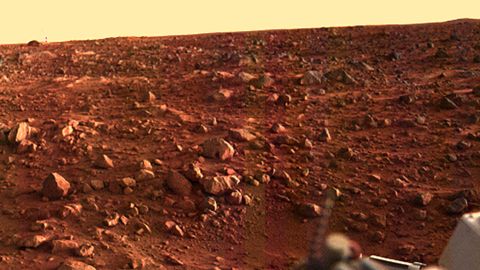Viking 1 may have landed at site of ancient Martian megatsunami
Sign up for CNN’s Wonder Theory science newsletter. Explore the universe with news on fascinating discoveries, scientific advancements and more.
CNN
—
When NASA’s Viking 1 lander made history as the first spacecraft to touch down on Mars on July 20, 1976, it sent back images of a landscape no one was expecting.
Those first images taken from the ground there showed a surprisingly boulder-strewn surface in the red planet’s northern equatorial region, rather than the smooth plains and flood channels expected based on images of the area taken from space.
The mystery of the Viking landing site has long puzzled scientists, who believe an ocean once existed there.
Now, new research suggests that the lander touched down where a Martian megatsunami deposited materials 3.4 billion years ago, according to a study published Thursday in the journal Scientific Reports.
The catastrophic event likely occurred when an asteroid slammed into the shallow Martian ocean — similar to the Chicxulub asteroid impact that wiped out dinosaurs on Earth 66 million years ago, according to researchers.
Five years before the Viking I landing, NASA’s Mariner 9 spacecraft had orbited Mars, spotting the first landscapes on another planet that suggested evidence of ancient flood channels there.
The interest in the potential for life on the red planet prompted scientists to select its northern equatorial region, Chryse Planitia, as the first Martian landing site for Viking I.
“The lander was designed to seek evidence of extant life on the Martian surface, so to select a suitable landing site, the engineers and scientists at the time faced the arduous task of using some of the planet’s earliest acquired images, accompanied by Earth-based radar probing of the planet’s surface,” said lead study author Alexis Rodriguez, senior scientist at the Planetary Science Institute in Tucson, Arizona, via email.
“The landing site selection needed to fulfill a critical requirement — the presence of extensive evidence of former surface water. On Earth, life always requires the presence of water to exist.”

At first, scientists thought the rocky surface might be a thick layer of debris left behind due to space rocks crashing into Mars and creating craters, or broken pieces of lava.
But there weren’t enough craters nearby, and lava fragments proved rare on the ground at the site.
“Our investigation provides a new solution — that a megatsunami washed ashore, emplacing sediments on which, about 3.4 billion years later, the Viking 1 lander touched down,” Rodriguez said.
The researchers believe the tsunami occurred when an asteroid or comet hit the planet’s northern ocean. But finding a resulting impact crater has been difficult.
Rodriguez and his team studied maps of the Martian surface created from different missions and analyzed a newly identified crater…
Read More: Viking 1 may have landed at site of ancient Martian megatsunami
